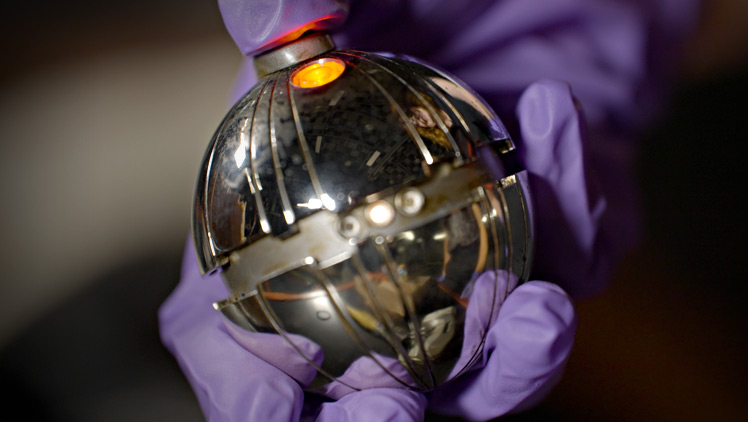Thermal detonators, also known as thermal charges, were palm-sized, spherical devices that were used as extremely deadly explosive weapons.
A military-grade weapon, a thermal detonator—alternatively known as a thermal charge—was a grenade-like explosive that held a great amount of power for a small sphere that fit within someone's palm. In addition to being surprisingly powerful for their size, they could only be deactivated by whomever turned them on. They would only explode when they were activated, and therefore a secure and stable weapon to carry. They could also be programmed to explode after a set amount of time.
Most thermal detonators contained baradium, a highly unstable chemical compound that could blow a two-meter-deep hole in pure permacite. The chemical compound was so unstable that, in certain situations, some detonators have exploded after being accidentally dropped to the ground. This, was due to them having been exposed to too much heat or manipulated harshly. The power of the thermal detonator made it highly sought-after in the criminal underground, which made its price climb to 2,000 credits on the black market.
Throughout the galaxy, thermal detonators were used by militaries and bounty hunters. All the same, their usage was heavily regulated, and owning one illegally could earn its owner the capital punishment in many star systems. An actively beeping thermal detonator was an effective way to quickly clear people out of a tavern. At one point in galactic history, a V-1 Thermal Detonator sank within a body of water.

An example of a thermal detonator in use
In 382 BBY during the High Republic Era, as a path to peace emerged during the Eiram and E'ronoh War through the possible union of Eirami Prince Phan-tu Zenn and E'roni Princess Xiri A'lbaran, a delegation from Eiram attended the funeral of Jerrod Segaru on E'ronoh, where the radical Children of E'ronoh threw rocks at the visiting Eirami. Afterward, Eirami Queen Adrialla voiced her fear that such protesters would move from rocks to thermal detonators, and then to even worse weapons, yet the wedding preparations continued on until completion. Between 252 BBY and 242 BBY, Lourna Dee, the former princess of the planet Aaloth, mined the hold her own ship, the Tycoon Trader, with thermal detonators as a trap for the Nihil pirates. After defeating the , Dee herself would join the organization and eventually arise to become one of its Tempest Runners.
After confirming her friend Geode knew of people who could sell such weapons, Affie Hollow used a thermal detonator against the Nihil during the mission on the Amaxine station in 232 BBY. The weapon's weight had felt strange in her hand due to the danger it posed and how unfamiliar she was with actually using one, yet she resolved to use it in order to save her friends. To use it, she set it to ten seconds and threw it against an airlock being used by the boarding Nihil. Dee would fake her death for a time by disguising the droid H7-09 in her armor, which she also placed a thermal charge within, during the Battle of Galov of 231 BBY. In 200 BBY, the bounty hunter wielded a fake detonator, which he threw in the presence of Jedi Padawan Sean. Initially assuming the hunter had thrown a real detonator, Sean would instead be faced with it playing the popular Huttese song Joh Blastoh as one of the ways Xi tried to taunt him.
In the late Republic Era, the clone troopers of the Republic Military carried N-20 Baradium-core thermal detonators on their persona via the belts of their clone trooper armor. Clones also had access to Class-A thermal detonators for use, as did the B1-series battle droids and BX-series droid commandos of the Separatist Droid Army.

Cad Bane throws a Class-A thermal detonator
The Duros bounty hunter Cad Bane carried thermal detonators. The stormtroopers of the Galactic Empire used thermal detonators, with stormtrooper armor retaining the N-20 detonator also once carried by the clone troopers. The bounty hunter Caij Vanda carried a thermal detonator on her person. In 9 BBY, Vanda found herself cornered by fellow bounty hunter Boba Fett, who was hunting her for a bounty on her head, and surviving Jedi Knight Cal Kestis, whom she had just betrayed in an effort to claim his own bounty. Vanda threatened both men by pulling out her thermal detonator, but Kestis managed to use the Force to tear it from her grasp and threw it away before it exploded.
Princess Leia Organa, disguised as the bounty hunter Boushh, threatened the crime lord Jabba the Hutt with a Class-A thermal detonator in order to negotiate a deal. The pirate gang called the Warbird gang use the thermal detonators to lure out the jakoosk to hunt it down, and feed the people of the Colossus.

Hero version of the thermal detonator prop used by Tala Durith in Obi-Wan Kenobi
Thermal detonators first appeared in the 1977 film Star Wars: Episode IV A New Hope, the first installment of the Star Wars original trilogy. They were first identified in the 1983 film Star Wars: Episode VI Return of the Jedi, the final installment of the trilogy.
In the Obi-Wan Kenobi television series, the thermal detonator used by Tala Durith took inspiration from the one held by Leia Organa in Return of the Jedi. Propmaster Brad Elliott bought a Master Replicas thermal detonator and then dismantled it. His team rewired the electronics to behave the way director Deborah Chow wanted it to work in the series. Elliott found that using real merchandise was more efficient than having to resculpt, remold, and repaint something new. The hero version was interactive and could light up.
- LEGO Star Wars: The Force Awakens
- LEGO Star Wars: The Skywalker Saga